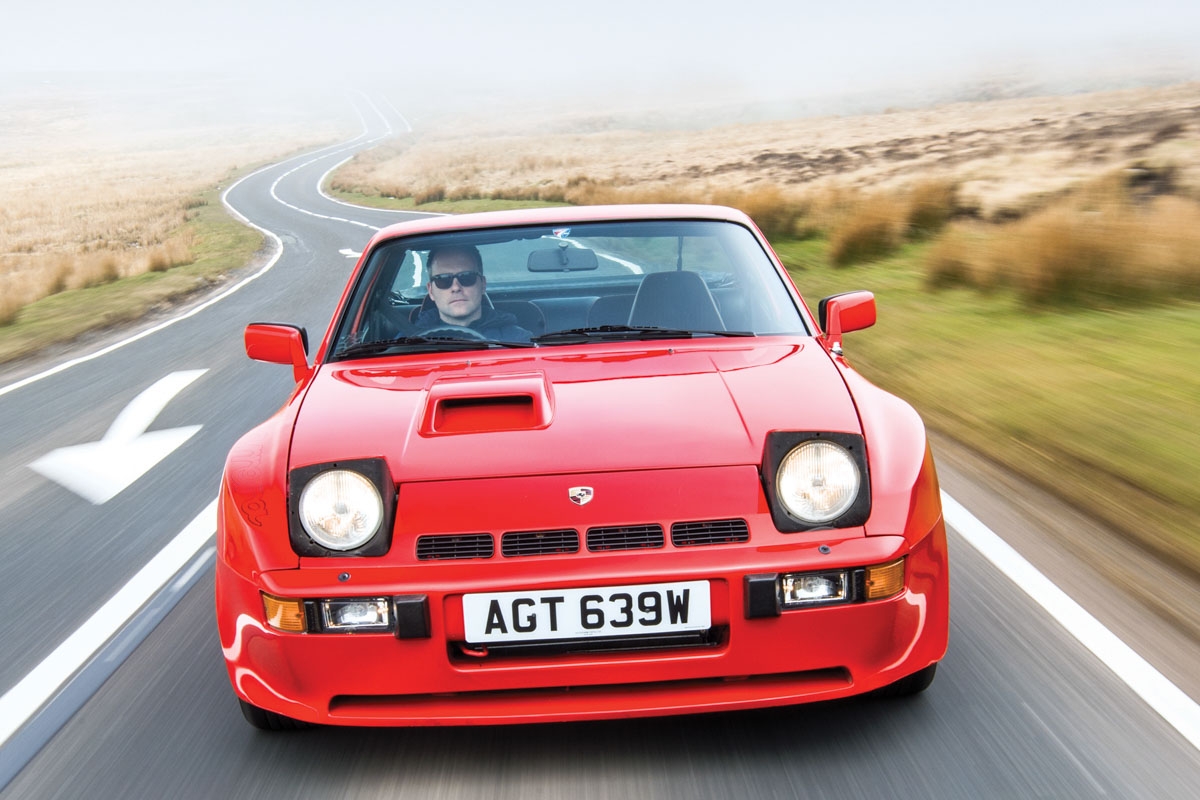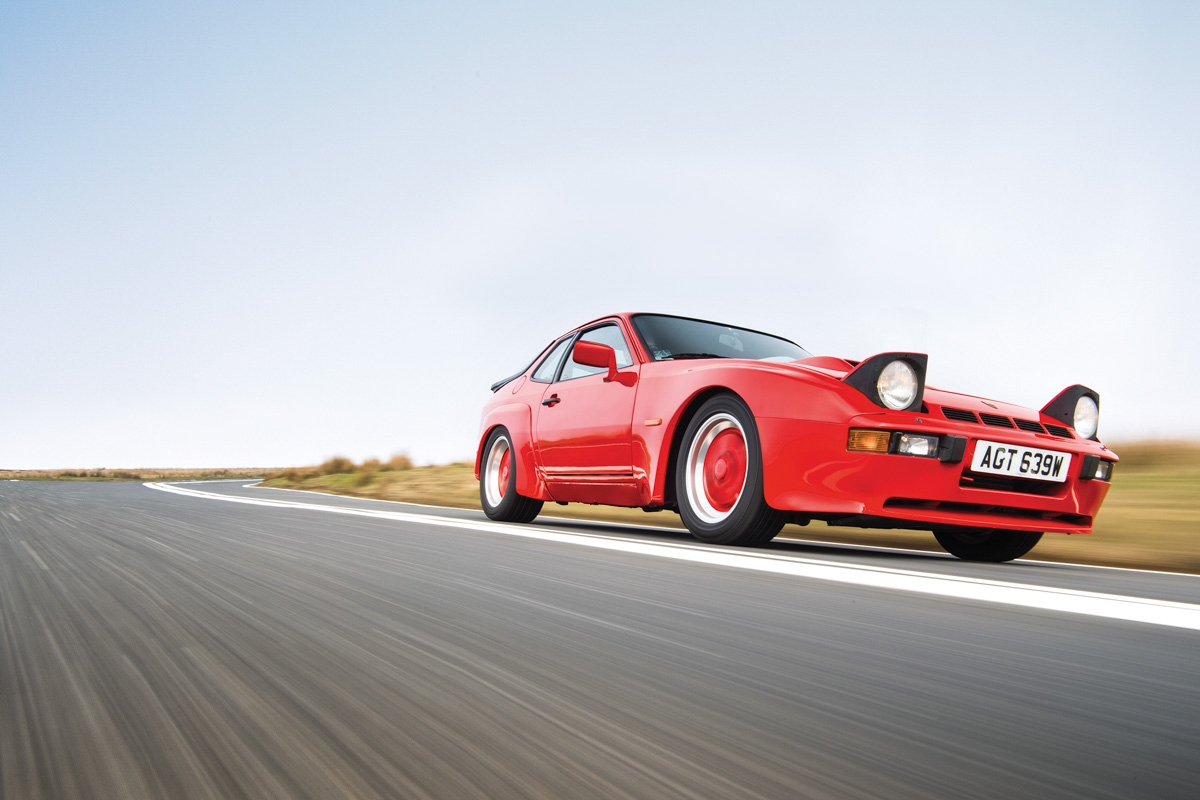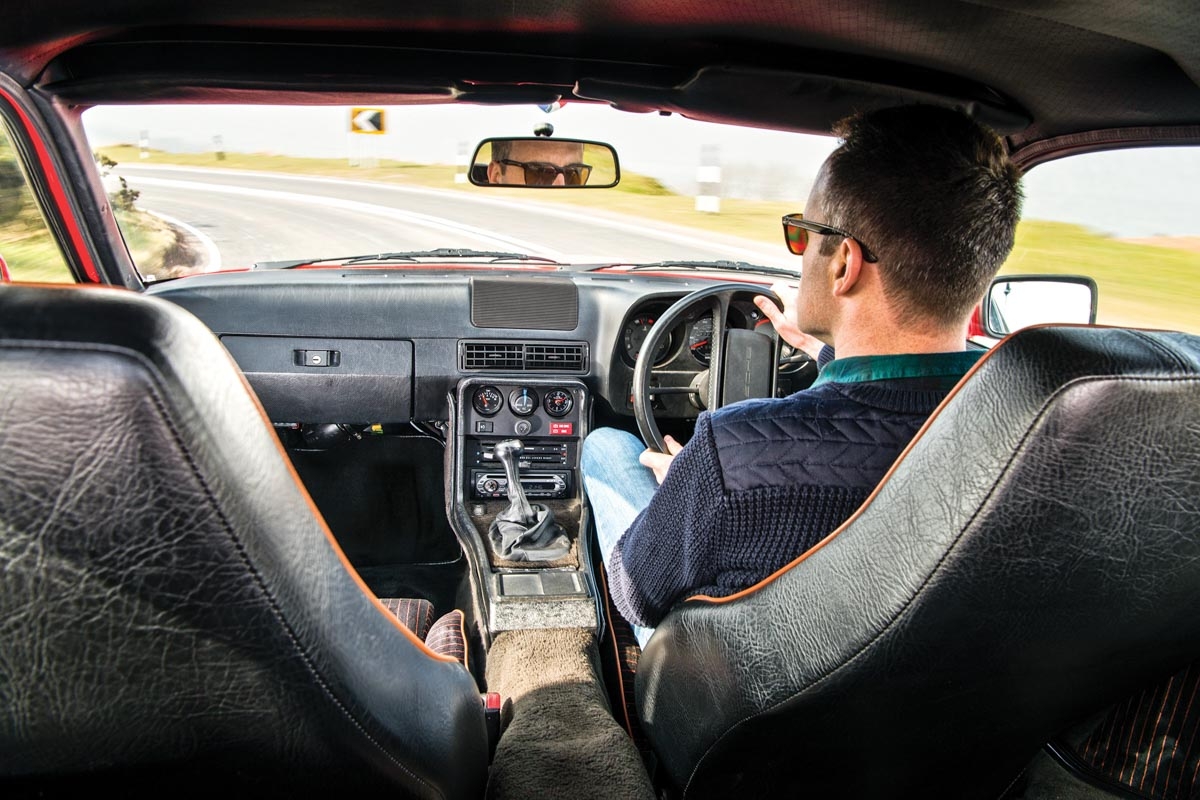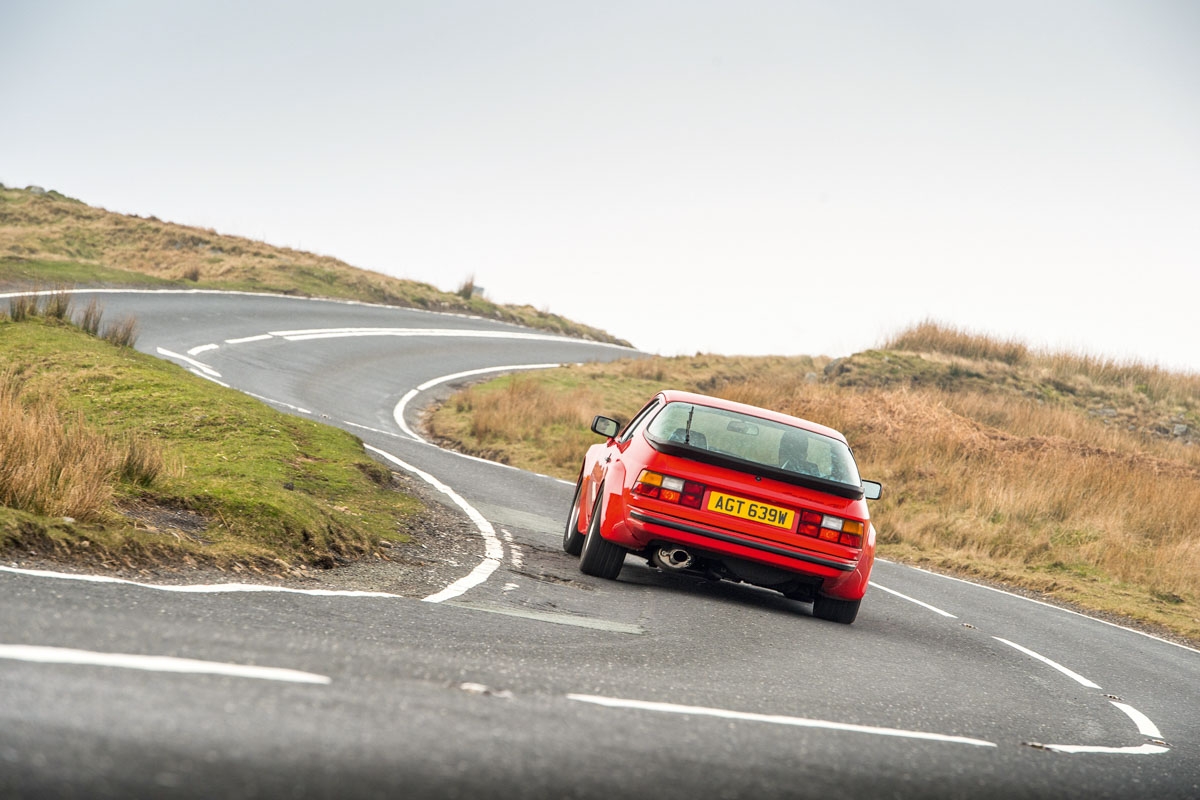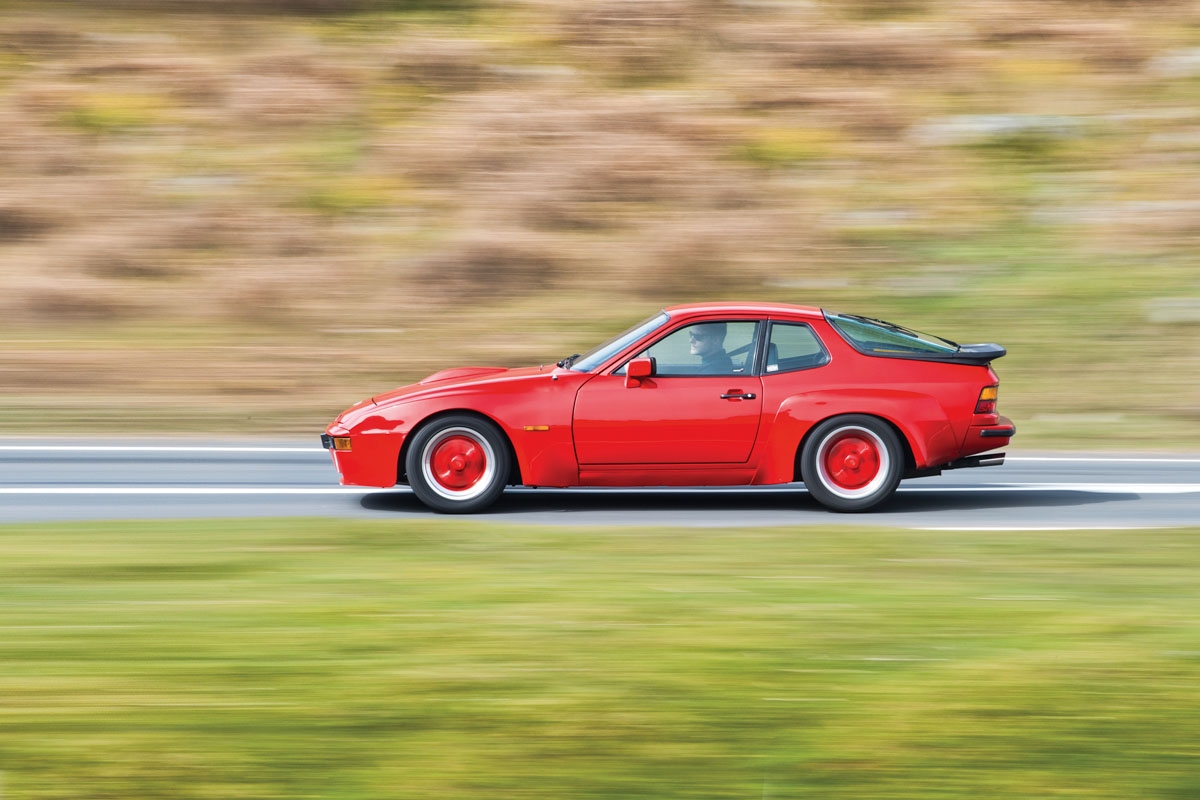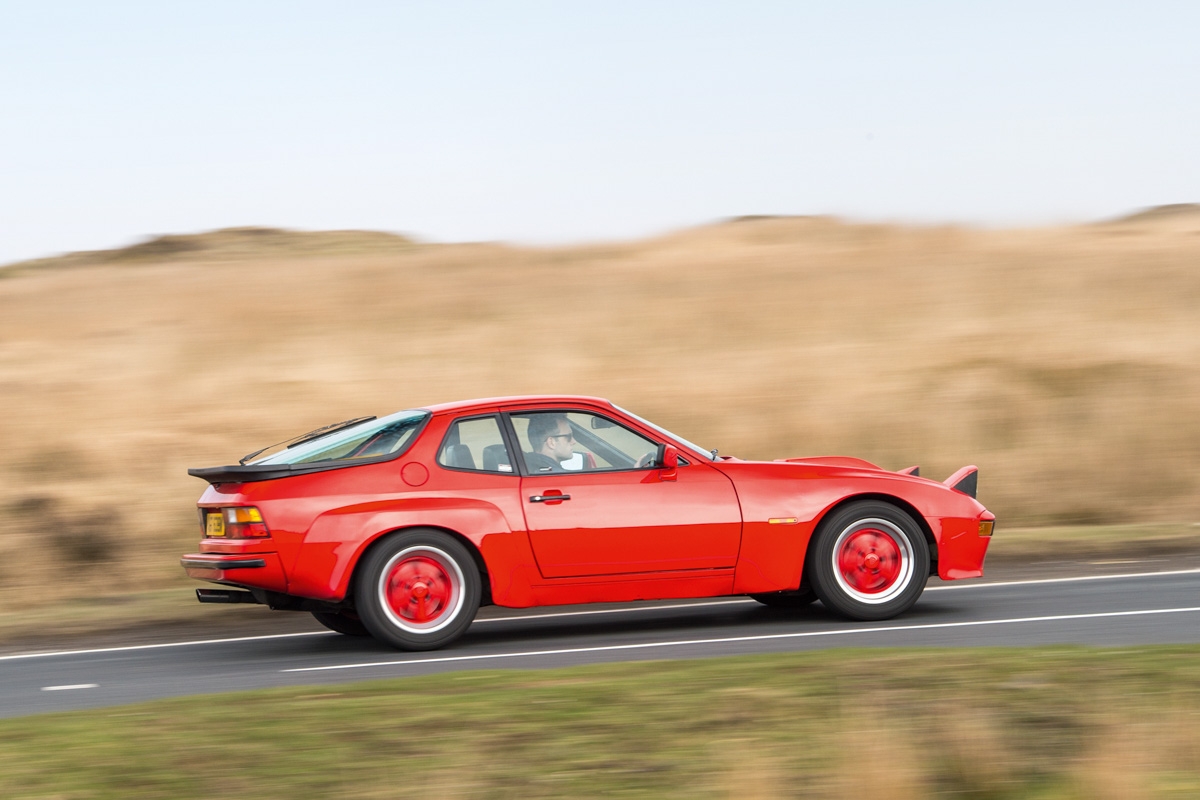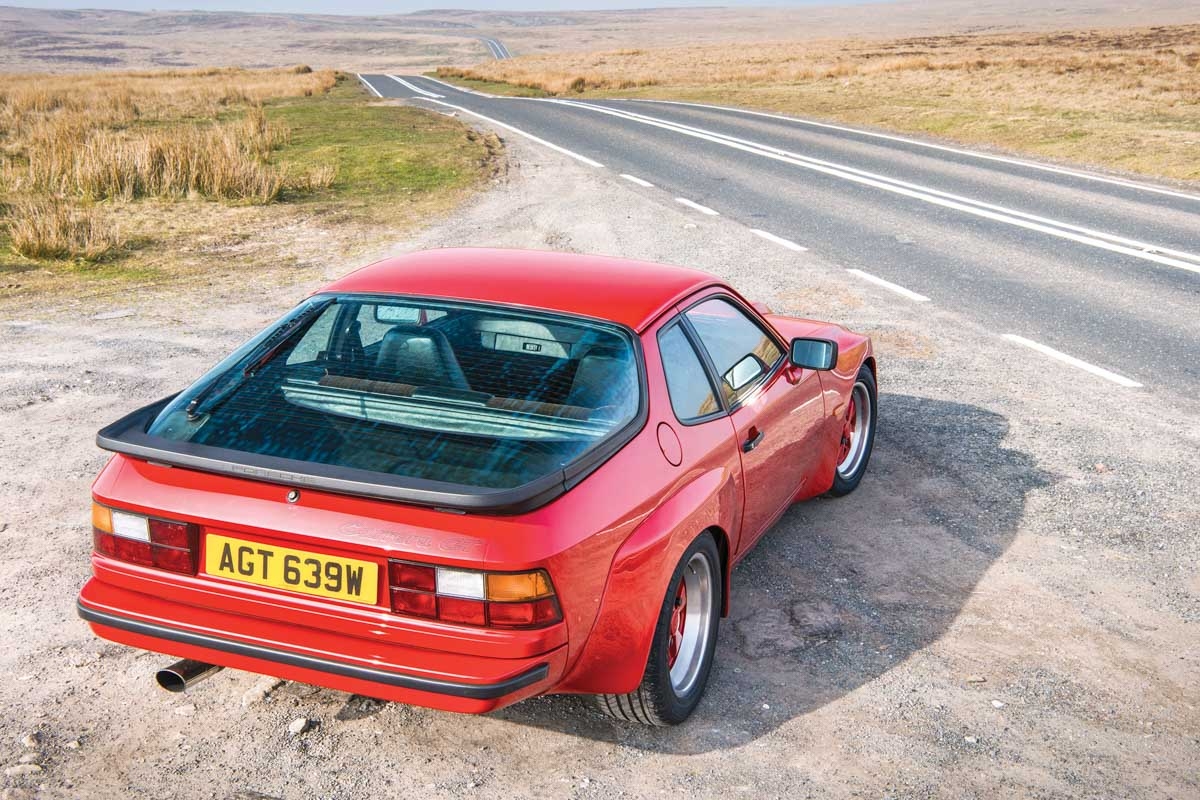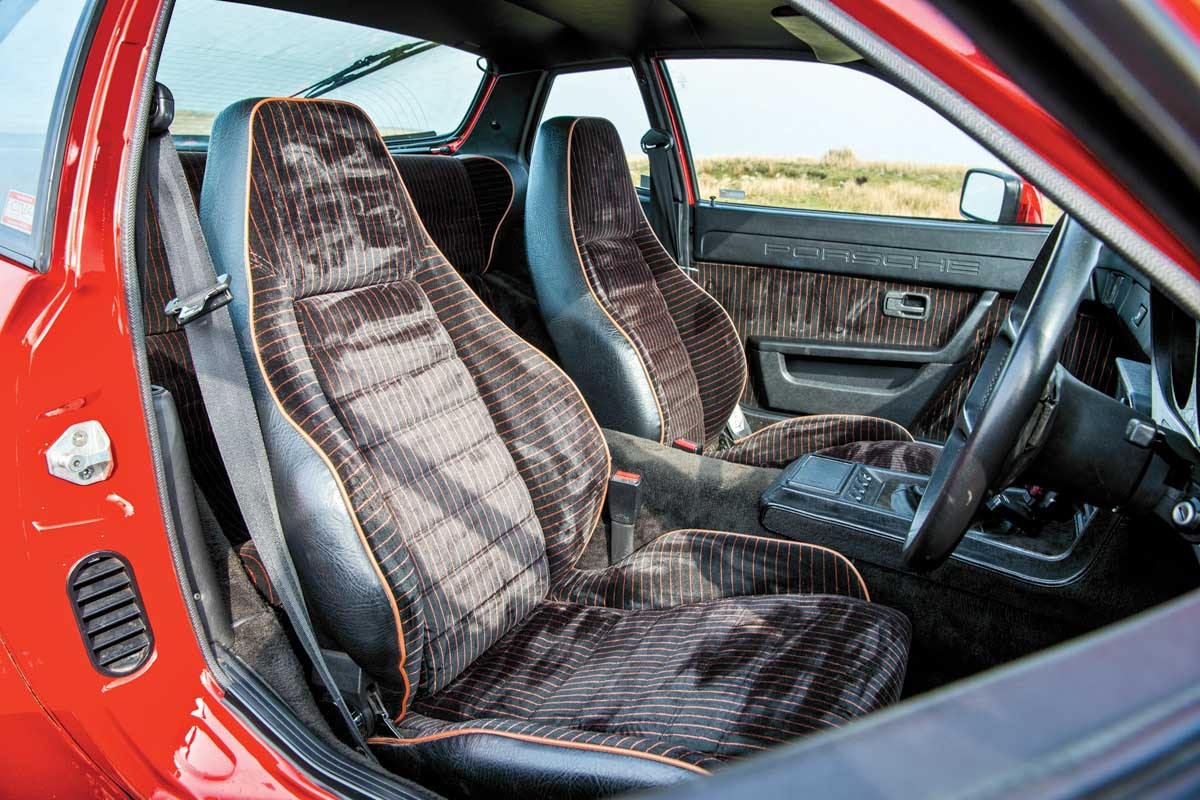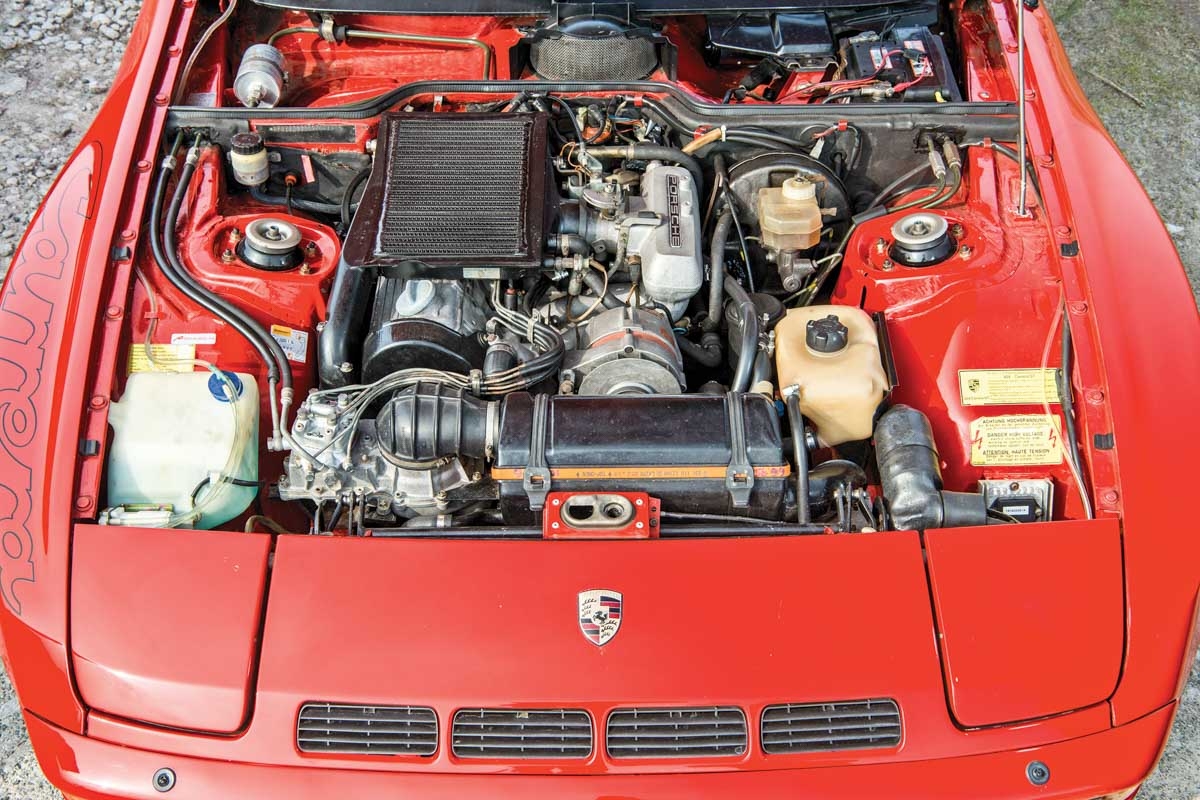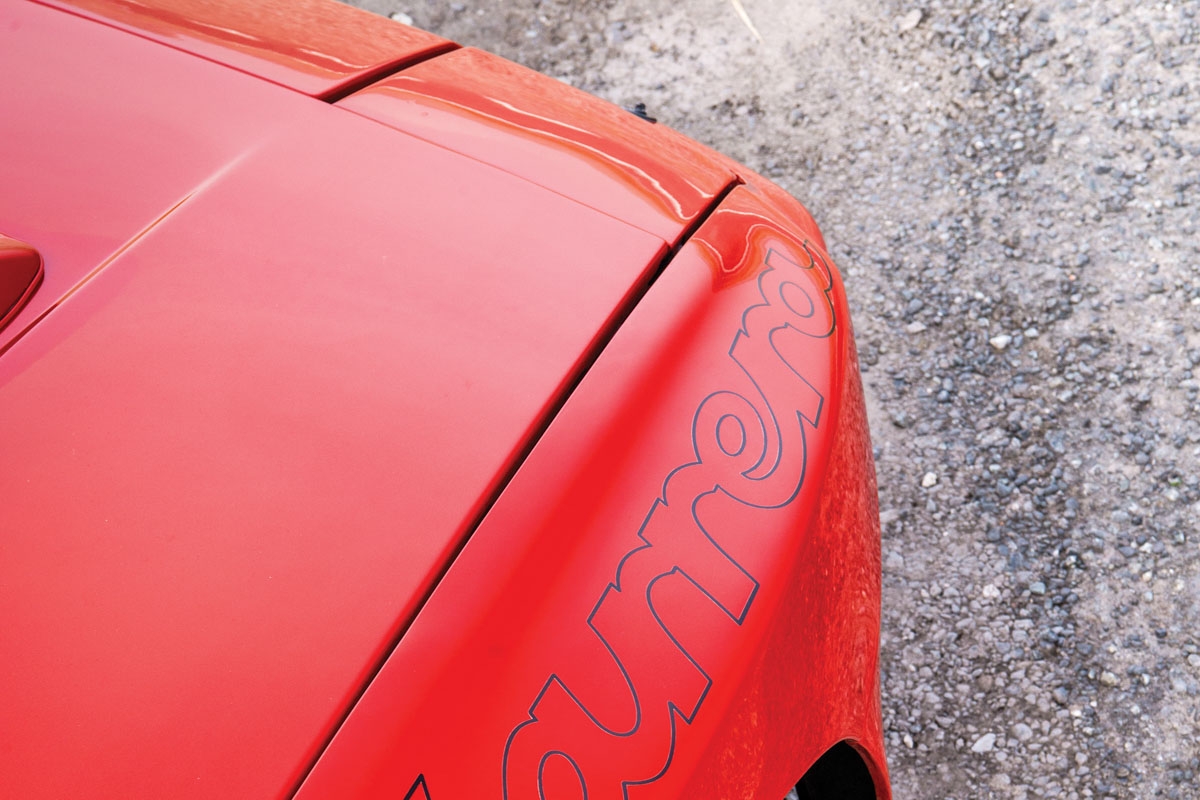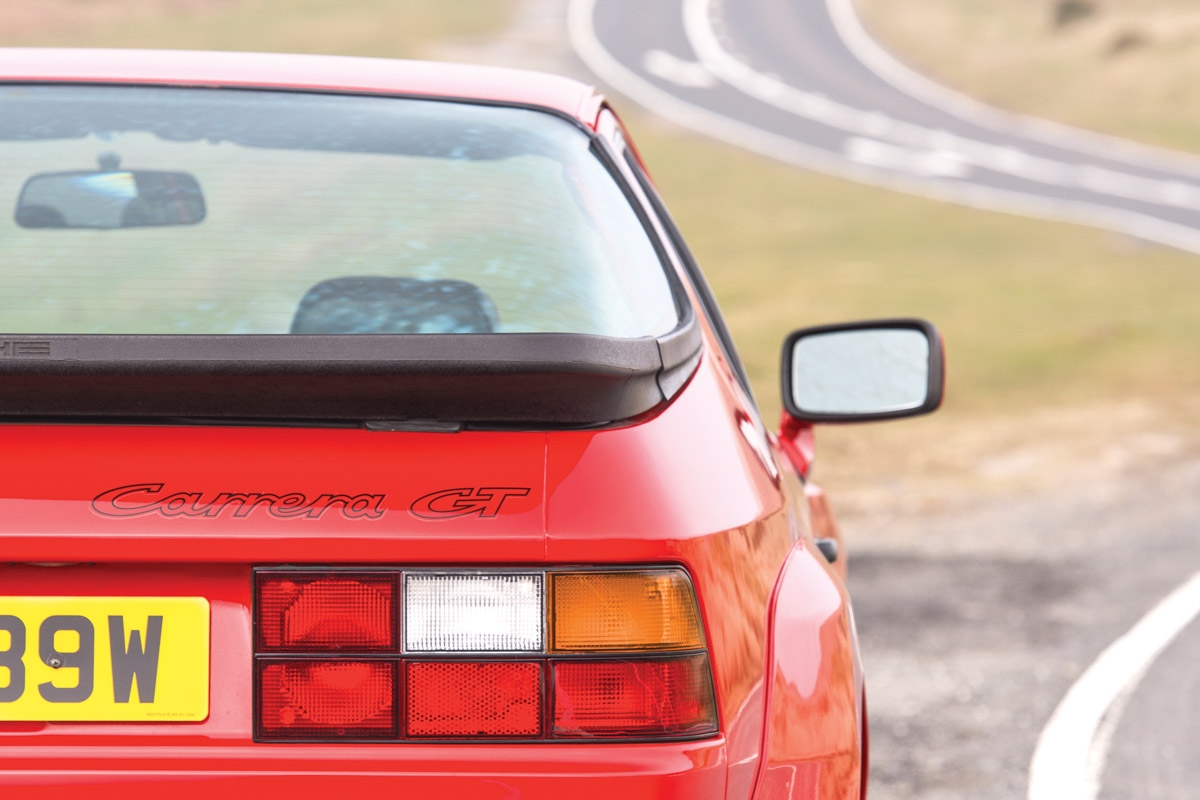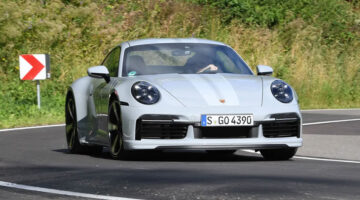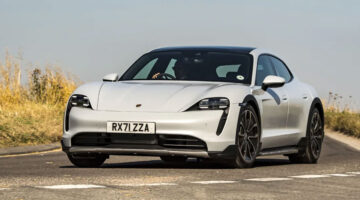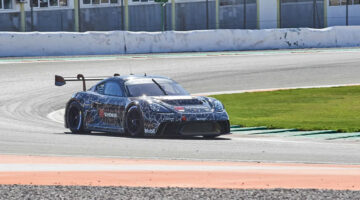A 2-litre, four-cylinder Porsche in the showroom; a 2-litre, four-cylinder Porsche racing in the Le Mans 24 Hours. How very 2017.
Or not. This little red coupe doesn’t look contemporary in the slightest: it’s as redolent of late-’70s Germany as a free-flowing autobahn or the crisp analogue bleeps and squelches of a Kraftwerk album. It actually smells of period West German industrial thoroughness, an aroma that probably boasts a terrifyingly long compound noun all of its own.
Porsche loved to link the current flat-four 718 Boxster/Cayman and the soon-to-be-defunct V4-powered 919 LMP1 programme, but back in the early ’80s it had a much more traditional homologation car, one that did indeed win at Le Mans, albeit in this case a class victory.
Its basis was the 924 Turbo, a 168bhp high- performance version of the little 924, itself the bottom rung of Porsche’s road car range. Originally a sports car project engineered for Volkswagen and designated EA425, it was canned by VW in the mid-’70s when it had a change of senior management, which left Porsche with a particularly acute headache. Eventually it bought the entire programme for a million Deutschmarks, including the use of the 2-litre Audi engine (often rather cruelly dubbed ‘a VW van engine’) and an agreement to build the car in Audi’s Neckarsulm factory. The resolutely logical, front-engined, water-cooled, 123bhp 924 and its big brother, the V8-powered 928, were the machines that then-Porsche-boss Ernst Fuhrmann intended to use to bury that smelly, noisy, rather weird car, the 911, once and for all – by 1980, in fact. Of course, it didn’t quite work out like that.
In 1979, four years into 924 production, visitors to the Frankfurt motor showwere confronted with a rather special, pearl-white 924 on the Porsche stand, the new car adorned with the revered Carrera badge. In this era, ‘Carrera’ was still reserved strictly for high- performance derivatives, not applied as a ‘given’ to even the most basic 911, as it was from 1983 onwards.
This concept car gave a very clear indication of the forthcoming Carrera GT production car, save for a curious bonnet intake that looked like an anteater’s snout, replaced by a boxier one for production. The garish tomato-red interior didn’t make it either – thankfully – but the idea of a real driver’s 924, for use in amateur motorsport as well as fast road driving, was widely welcomed. As it is today with the Cayman GT4 Clubsport.
This was Porsche going back to its roots and its early days with flat-fours. What’s more, there was a surprise announcement: the factory motorsport team would run the car at Le Mans. After a decade of success in the world’s greatest 24-hour race, this would be no outright bid for glory, but there would be three of the 2-litre coupes on the entry list. Porsche’s head of R&D, Helmuth Bott, was reported to have remarked: ‘If I wanted to make a Black Forest Gateau, I wouldn’t start with a bucket of sand and a bucket of water.’ Clearly not everyone had read the company’s pre-show internal PR memo…
Four hundred examples of the wide-arched Carrera GT would need to be made to qualify the car for competition. Power was raised to 207bhp with the aid of an intercooler mounted on top of the engine (and fed by that scoop), a higher compression ratio and – for the first time on a production Porsche – digital ignition. Glassfibre was used for the arch extensions and sills, and the car was lowered 10mm at the front and 15mm at the rear compared with the standard Turbo, although that car’s ‘luxury’ interior was carried over. They came in either silver, black or red, with just 75 made in right- hand drive in the region, all pre-sold.
There were also 59 Carrera GTS road cars, all left-hand drive and red, featuring fixed headlamps under Perspex covers (instead of the GT’s evocative ‘pop up’ lamps) and running more boost (1bar instead of 0.75) to make 242bhp with 247lb ft of torque (up from the GT’s 207lb ft). Weight was reduced in the GTS by 59kg, dropping the overall kerb weight from an already fairly lithe 1180kg to 1121kg. Of those 59 cars, 15 were finished to Clubsport specification, which meant they were lighter still (1060kg), had a roll-cage fitted and ran even more boost for 266bhp. Finally, there were the 19 race versions, known as the GTRs, weighing around 930kg, and with the little four- pot tuned to 320bhp. You’ll never mistake the 290kph-plus GTR: its bespoke wide panelwork entirely belies the size and humble nature of the engine beneath: it’s a monster.
So the 924 Carrera GT is very much the real deal in the grand history of the homologation special, and parked in front of me today it exudes a confidence typically born from those credentials. The red Fuchs alloy wheels, those oversized, bold graphics, the swollen but purely functional arches… I am fairly hopping from one foot to the other with excitement.
Inside it’s very, very dark. There are two chunky sports seats, covered in a pin-striped velour that has a particularly ripe, 36-year-old smell. Squidgy under the posterior, they’re actually very supportive. The switchgear is resolutely, almost fanatically simple in the best Teutonic style. And while the gaps between the sections of interior trim are cavernous in places, and the whole car chirps away like a cage full of budgies at speed, the plastic used has a solidity that needs to be touched to be understood. It feels as though nothing could wear this car out.
The first challenge is finding a comfortable driving position. As anyone who’s driven a 924 or an original 944 can attest, the steering column exits the dash on a curiously low trajectory. Coupled with a driver’s seat that would ideally adjust lower, the result is a steering wheel deposited right in my lap. Solution number one involves sliding the seat a long way aft, allowing my feet to find the pedals at a reasonable angle, but with the drawback that my arms are almost straight to reach the wheel. Option two is to move nearer but have both legs contorted around the wheel in a really awkward fashion. Given my knees aren’t double-jointed, any heel-and-toe action will be physically impossible. It’s a shame, and something that Porsche only sorted with the advent of the Series 2 944 in 1985.
Still, it’s a Carrera GT, and I’m not allowed to let a bit of knee and shoulder ache spoil the moment. The second significant revelation about the CGT is the disarmingly uncouth nature of the engine. It chunters into life and then idles with all the sophistication of a machine found in a civil engineering plant yard. It’s not just an aural thing, although it would be exceedingly charitable to call it anything more than gravelly and workmanlike; it’s also the way it sends tremors through the bodyshell. ‘Rough’ would be harsh, but probably fair.
Further confirmation of the car’s no- nonsense homologation ethos is provided by the dog-leg gearbox, which requires quite some force to work around the ratios. I also make a mental note to remember the pattern of the gate, particularly when moving off from rest.
Let the clutch out in a sympathetic fashion and depress the accelerator at low revs and the car feels as though the handbrake has been left on. So you squeeze the throttle with more determination, and still there’s nothing: this is turbo lag of a magnitude completely alien to a younger generation.
Finally, as the needle sweeps past 3000rpm, then 4000rpm, a whistling sound heralds the arrival of boost and the whole car seems to lighten, as if unchained from a great weight that it’s been dragging along behind it, gouging a furrow in the asphalt. To be perfectly honest, it’s not a massive kick in the back, but suddenly the Carrera GT feels fast and keen. While the 2-litre eight-valve motor predictably gets very coarse once past 5500rpm, it is undeniably enthusiastic to get to work.
Armed with the knowledge that it might be better walking than driving the CGT in a half-hearted fashion, I try to summon as much commitment and forward anticipation as I possibly can to keep the engine spinning above 4000rpm at all times. The little Porsche seems to love it: it’s a beautiful, highly original example, owned by a knowledgeable Porsche collector, and after some recent restorative work feels as though it needs a few kilometre to shake off the storage blues. I swear that by the end of the day it’s a much happier car.
The Carrera GT on song feels fast – certainly properly fast by the standards of 1981, where it must have surged past columns of slower- moving traffic in punctuated gusts of boost. It’s also clearly a car that wants to be enjoyed in the corners as much as on the straights, partly through the innate balance of the transaxle layout. In essence, driving this Porsche rapidly down a twisting road is like painstakingly piecing together a three-dimensional puzzle. It’s not enough just to think about cornering lines, braking points and suchlike; revs, gear choice and making a clean shift are all absolutely critical if it’s to come together, otherwise the car bogs down, progress is squandered, and you’re left feeling ham-fisted.
Trouble is, without being able to work the pedals properly, I just can’t seem to get a proper grip on manipulating the CGT to be in the right state at exactly the right time. The unassisted steering is very heavy at low speeds, and, while it does lighten once we’re properly on the move, it weights up strongly once a significant turn is made, possibly exacerbated by incorrect geometry, which remains on the owner’s to- do list. The odds look long on being able to catch any slide should the tail lose traction. Unsurprisingly, it’s softly sprung, but the initial body roll is kept largely in check. In short, the potential is abundantly clear – I just don’t feel I’ve been able to make the most of it. Driving a well-set-up Carrera GTS a few years ago – with period bucket seats for a lower driving position – proved just how enjoyable these cars can be.
There was no way Porsche could build the necessary number of cars to qualify the 924 Carrera GTR for homologation approval in time for Le Mans in 1980, so the cars ran as GTP models. Three were entered by the factory: a ‘German’ car, a ‘USA’ car, and a ‘British’ car, the latter driven by touring car legend Andy Rouse and journalist and racer Tony Dron, a formidable pairing.
All three cars gained places in the race, but the British car completed the final six hours on just three cylinders to finish 13th. The American 924 was 12th, while the German car, running a richer fuel mixture and untroubled, finished sixth. Dron and Rouse had been wary of engine problems after losing an engine in testing and considered easing off on the straights, only to be reassured by the team that the issue had been solved. If they’d followed their intuition, Dron believes a fourth-place finish was on the cards, which would have been an incredible result given the 322kph-plus competition.
In many ways the 924 Carrera GT remains an enigma. Launched at the peak of what would eventually turn into a product cul-de- sac for the company, it achieved largely what it was designed to do in motorsport before quickly being superseded by the new Group C regulations for the 1980s. It also bequeathed a design that was refined into the hugely successful 944, but for years it was viewed as an oddity in the company’s history and valued accordingly. Predictably, in these boom years of classic car values, that’s no longer the case, and while it’s an acquired taste in driving terms, it’s as authentic a Porsche motorsport product as anything air-cooled and rear-engined. It’s a genuine, if less well known, icon.
This article originally appeared at evo.co.uk
Copyright © evo UK, Dennis Publishing

